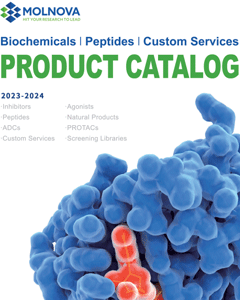
C2 Ceramide
CAS No. 3102-57-6
C2 Ceramide( —— )
Catalog No. M33837 CAS No. 3102-57-6
A potent modulator of cell proliferation and differentiation.
Purity : >98% (HPLC)
 COA
COA
 Datasheet
Datasheet
 HNMR
HNMR
 HPLC
HPLC
 MSDS
MSDS
 Handing Instructions
Handing Instructions
| Size | Price / USD | Stock | Quantity |
| 5MG | 92 | In Stock |


|
| 10MG | 132 | In Stock |


|
| 25MG | 214 | In Stock |


|
| 50MG | 317 | In Stock |


|
| 100MG | 461 | In Stock |


|
| 500MG | Get Quote | In Stock |


|
| 1G | Get Quote | In Stock |


|
Biological Information
-
Product NameC2 Ceramide
-
NoteResearch use only, not for human use.
-
Brief DescriptionA potent modulator of cell proliferation and differentiation.
-
DescriptionC2 Ceramide (Ceramide 2) is the main lipid of the stratum corneum and a protein phosphatase 1 (PP1) activator. C2 Ceramide activates PP2A and ceramide-activated protein phosphatase (CAPP). C2 Ceramide induces cells differentiation, autophagy and apoptosis, inhibits mitochondrial respiratory chain complex III. C2 Ceramide is also a skin conditioning agent that protects the epidermal barrier from water loss.
-
In VitroC2 Ceramide (5 nM-200 μM; 24 hours; primary mouse osteoblasts) treatment (≤500 nM) promots osteoblast viability, whilst concentrations ≥2 μM significantly reduces osteoblast viability in a dose- and time-dependent manner.C2 Ceramide increases cytoplasmic histone-associated DNA fragments by 5.7- and 11.2-fold at 50 μM and 100 μM C2 Ceramide concentrations respectively in osteoblasts. At these higher concentrations, C2 Ceramide is a potent inducer of apoptosis in osteoblasts. C2 Ceramide up-regulates mRNA expression of angiogenic genes in human dental pulp cells (HDPCs) and increases the migration and capillary tube formation of endothelial cells, whereas PP1 small interfering RNA shows opposite effects. Human dental pulp cells (HDPCs) increases levels of bone morphogenetic protein 2, phosphorylation of Smad 1/5/8, and mRNA expression of runt-related transcription factor 2 and osterix.Cell Viability Assay Cell Line:Primary mouse osteoblasts Concentration:5 nM-200 μM Incubation Time:24 hours Result:Murine osteoblasts demonstrated a dose-dependent increase in their survival rate when exposed to low concentrations of 5-500 n?M. Increasing concentrations of 20-200μM caused a dose-dependent decrease in mitochondrial succinate dehydrogenase activity and osteoblast survival.
-
In VivoThe PP1 activator C2 Ceramide increases alkaline phosphatase activity, mineralizes nodule formation, and mRNA expression of dentin matrix protein 1 and dentin sialophosphoprotein. In contrast, knockdown by PP1 small interfering RNA inhibits odontoblastic differentiation.
-
Synonyms——
-
PathwayOthers
-
TargetOther Targets
-
RecptorOthers
-
Research Area——
-
Indication——
Chemical Information
-
CAS Number3102-57-6
-
Formula Weight341.53
-
Molecular FormulaC20H39NO3
-
Purity>98% (HPLC)
-
SolubilityIn Vitro:?DMSO : 20 mg/mL (58.56 mM; )Ethanol : 17 mg/mL (49.78 mM)
-
SMILESCCCCCCCCCCCCC\C=C\[C@@H](O)[C@H](CO)NC(C)=O
-
Chemical Name——
Shipping & Storage Information
-
Storage(-20℃)
-
ShippingWith Ice Pack
-
Stability≥ 2 years
Reference
1. P A Hill, et al. Ceramide-induced Cell Death/Survival in Murine Osteoblasts. J Endocrinol. 2010 Aug;206(2):225-33.?
molnova catalog



related products
-
LY392098
LY392098 is a potentiator of AMPA receptor.
-
Melanocyte Associate...
Melanocyte Associated Antigen gp 100 (17 - 25)
-
Indicine hydrochlori...
The herbs of Heliotropium indicum.



 Cart
Cart
 sales@molnova.com
sales@molnova.com


